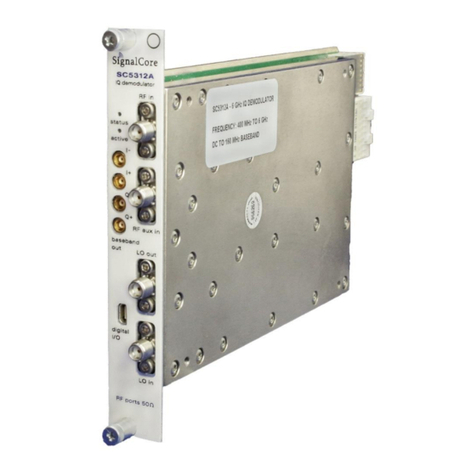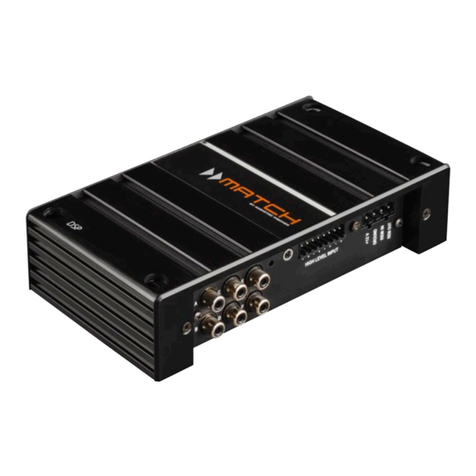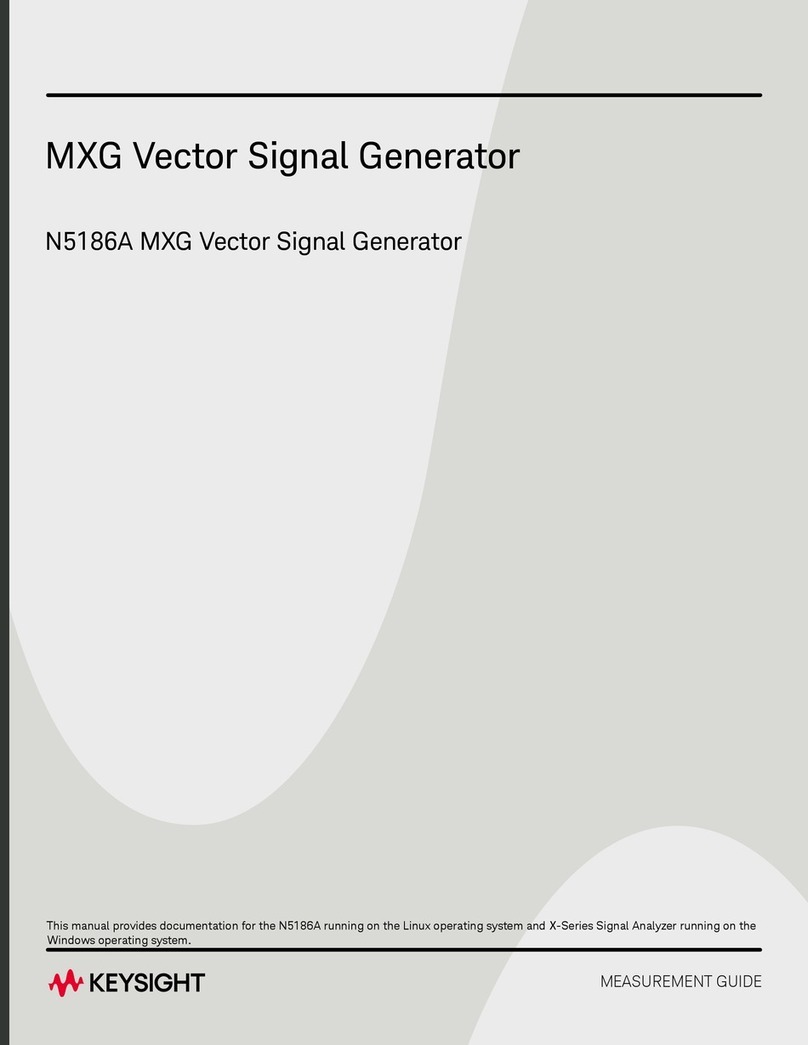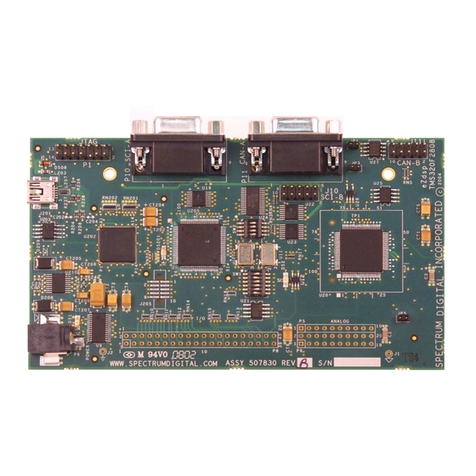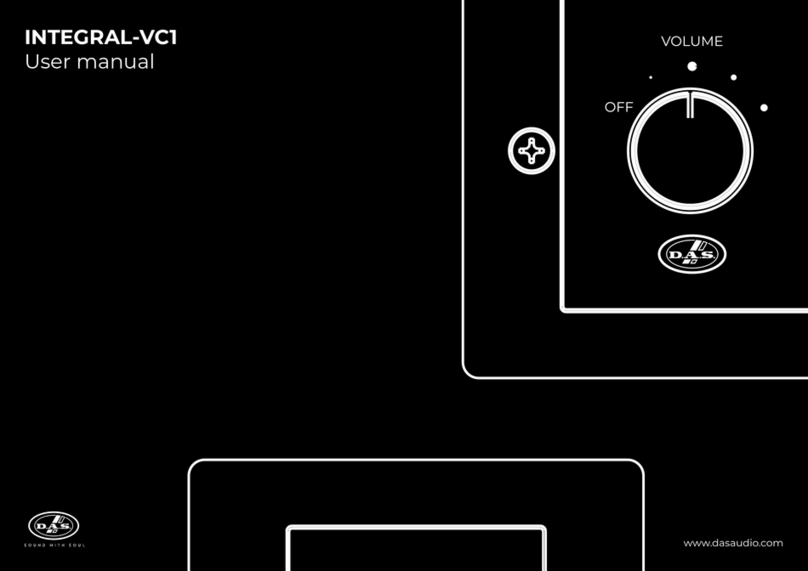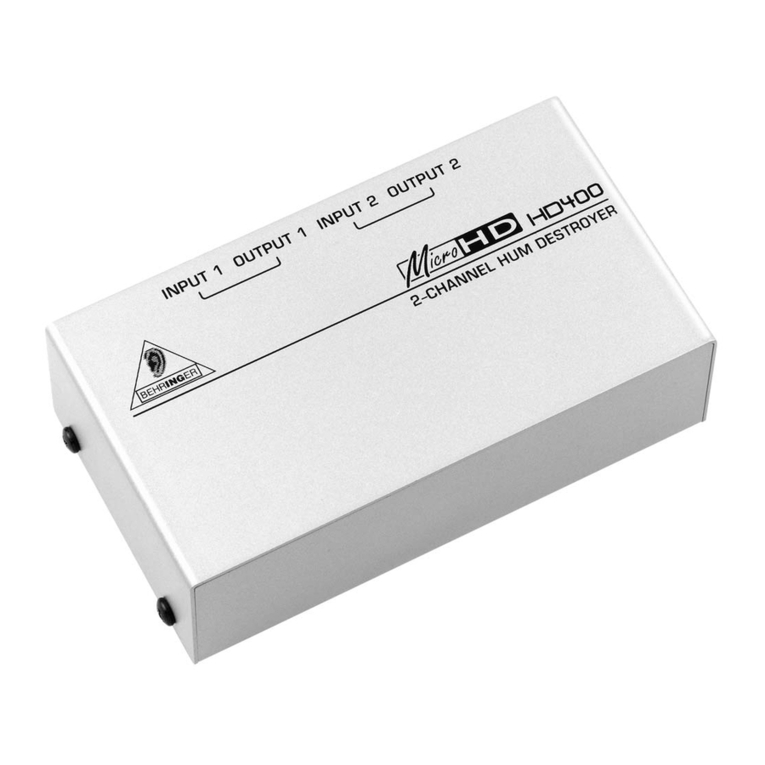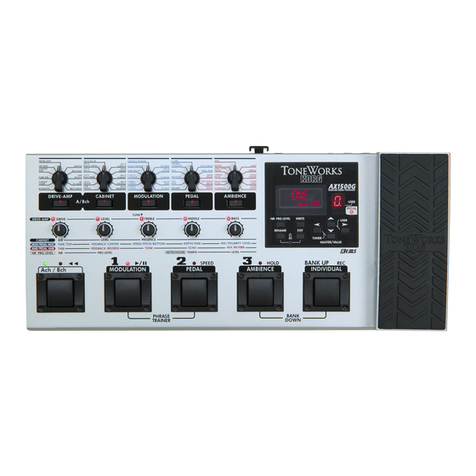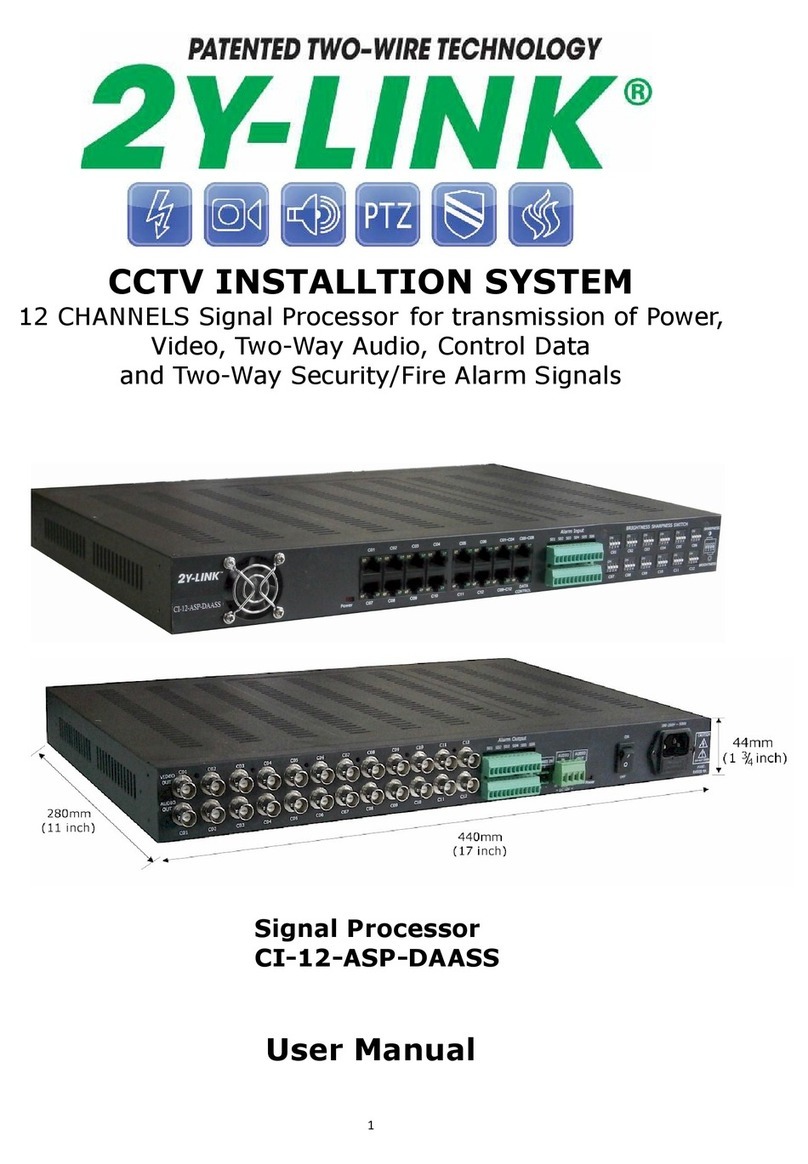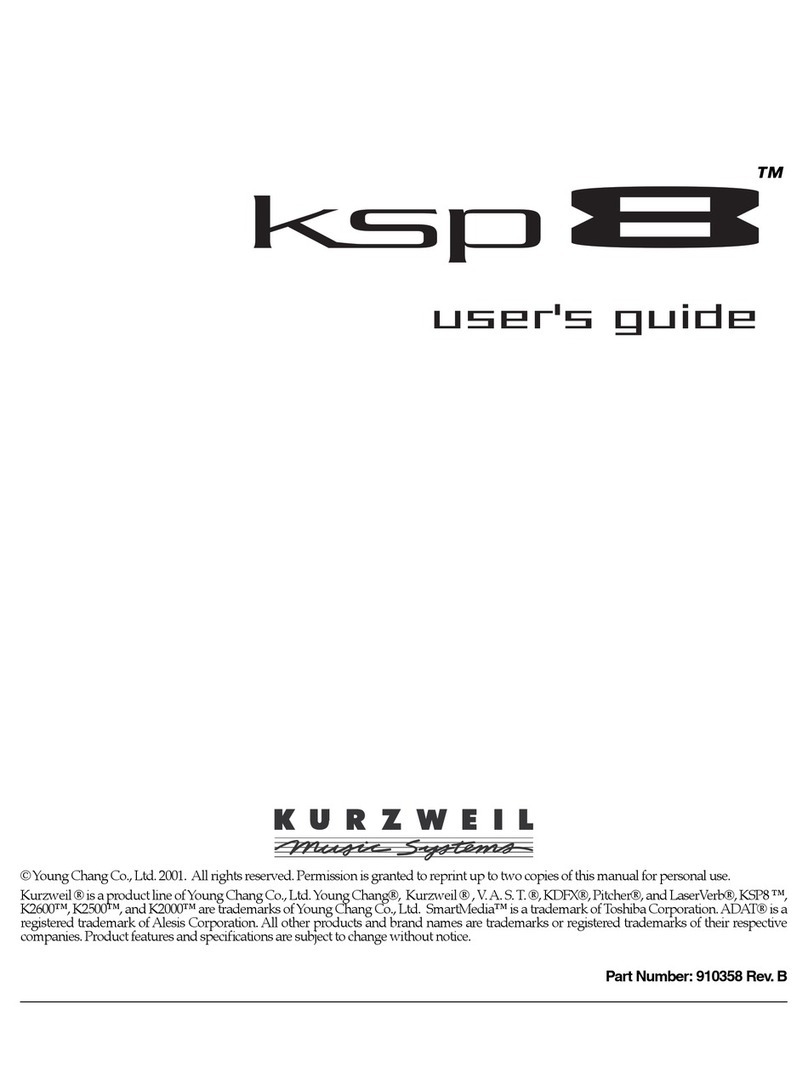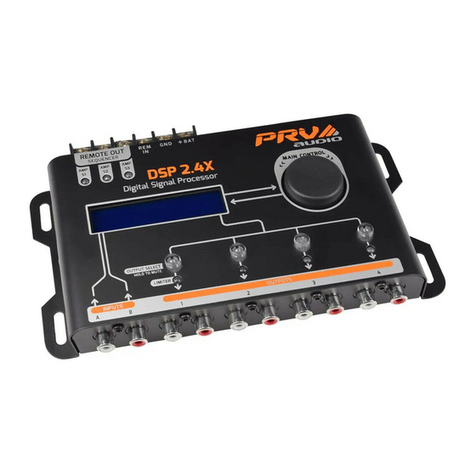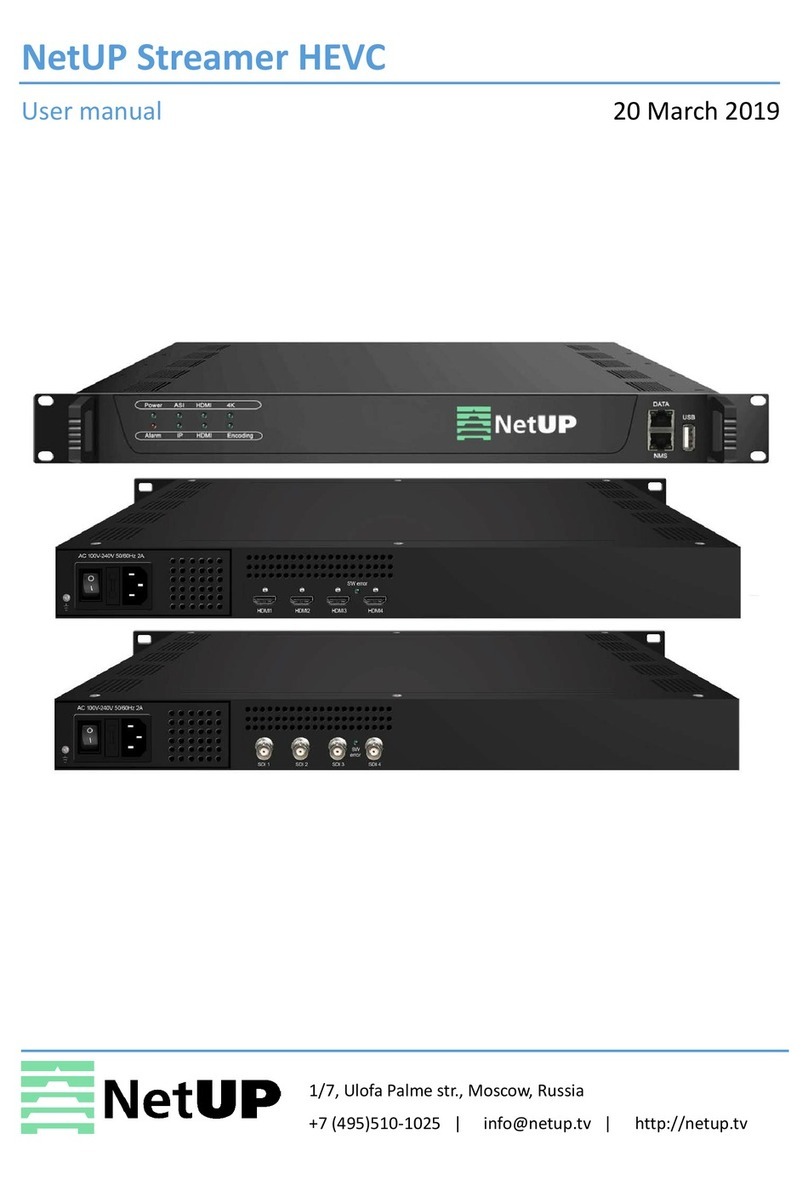SIGNALCORE SC5520A User manual

©2020 Rev 1.1
1
General Information
Table of Contents
1General Information..............................................................................................................................4
Warranty .......................................................................................................................................4
Copyright & Trademarks................................................................................................................4
International Materials Declarations.............................................................................................5
CE European Union EMC Declaration............................................................................................5
Warnings Regarding Use of SignalCore Products ..........................................................................5
2Physical Description...............................................................................................................................6
Unpacking......................................................................................................................................6
Nomenclature ...............................................................................................................................6
Setting Up and Configuring the UHFS Device ................................................................................6
Front Interface Indicators and Connectors....................................................................................7
Signal Connections ................................................................................................................8
Device LED Indicators ............................................................................................................8
Communication and Supply Connection ...............................................................................9
Mini-USB Connection ..........................................................................................................10
Reset Button (Pin Hole) .......................................................................................................10
3Theory and Operation .........................................................................................................................11
RF Generation..............................................................................................................................11
Amplitude Control.......................................................................................................................11
Reference Mode..........................................................................................................................12
Computational Time....................................................................................................................12
Internal EEPROM.........................................................................................................................12
Modes of RF Generation .............................................................................................................12
Sweep Function...................................................................................................................12
List Function ........................................................................................................................13
Sweep Direction ..................................................................................................................13
Sweep Waveform ................................................................................................................13
Dwell Time...........................................................................................................................13
List Cycles ............................................................................................................................13
Trigger Sources....................................................................................................................13
Hardware Trigger Modes.....................................................................................................14
Trigger Out Modes ..............................................................................................................14

Rev 1.1 | SC5520A & SC5521A Hardware Manual SignalCore, Inc.
2
Default Startup Mode..................................................................................................................14
4Hardware Registers .............................................................................................................................15
Configuration Registers ...............................................................................................................15
Register 0x01 INITIALIZE (1 Byte).........................................................................................16
Register 0x02 SET_SYS_ACTIVE (1 Byte)..............................................................................16
Register 0x03 SYNTH_MODE (1 Byte)..................................................................................17
Register 0x04 RF_MODE (1 Byte) ........................................................................................18
Register 0x05 LIST_MODE_CONFIG (1 Byte) .......................................................................18
Register 0x06 LIST_START_FREQ (7 Bytes)..........................................................................20
Register 0x07 LIST_STOP_FREQ (7 Bytes)............................................................................20
Register 0x08 LIST_STEP_FREQ (7 Bytes) ............................................................................20
Register 0x09 LIST_DWELL_TIME (7 Bytes) .........................................................................20
Register 0x0A LIST_CYCLE_COUNT (7 Bytes).......................................................................20
Register 0x0B Reserved .......................................................................................................21
Register 0x0C LIST_BUFFER_POINTS (3 Bytes) ....................................................................21
Register 0x0D LIST_BUFFER_WRITE (7 Bytes) .....................................................................22
Register 0x0E LIST_BUF_MEM_TRNSFER (1 Byte)...............................................................22
Register 0x0F LIST_SOFT_TRIGGER (1 Byte) ........................................................................22
Register 0x10 RF_FREQUENCY (7 Bytes)..............................................................................23
Register 0x11 RF_LEVEL (3 Bytes)........................................................................................23
Register 0x12 RF_ENABLE (1 Byte) ......................................................................................23
Register 0x13 RF_PHASE (7 Bytes).......................................................................................23
Register 0x14 AUTO_LEVEL_DISABLE (1 Byte).....................................................................24
Register 0x15 Reserved (1 Byte)..........................................................................................24
Register 0x16 RF_STANDBY (1 Byte)....................................................................................24
Register 0x17 REFERENCE_MODE (1 Byte)..........................................................................24
Register 0x18 REFERENCE_DAC_VALUE (3 Bytes) ...............................................................25
Register 0x1A RESERVED .....................................................................................................25
Register 0x1B STORE_DEFAULT_STATE (1 Byte)..................................................................25
Register 0x1C SELF_SYNTH_CAL (1 Byte).............................................................................25
Register 0x1D DIRECT_ATTEN .............................................................................................26
Query Registers ...........................................................................................................................26
Register 0x20 GET_RF_PARAMETERS (1 Byte sent, 8 Bytes received).................................26

©2020 Rev 1.1
3
General Information
Register 0x21 GET_TEMPERATURE (1 Byte, 8 Bytes)...........................................................27
Register 0x22 GET_DEVICE_STATUS (1 Byte, 8 Bytes).........................................................27
Register 0x23 GET_DEVICE_INFO (1 Byte, 8 Bytes) .............................................................30
Register 0x24 GET_LIST_BUFFER (3 Bytes, 8 Bytes) ............................................................30
Register 0x25 FETCH_DAC_VALUE (1 Byte, 8 Bytes) ...........................................................31
Register 0x26 SERIAL_OUT_BUFFER....................................................................................31
5Communication Interfaces ..................................................................................................................33
Communication Data Format ......................................................................................................33
USB Interface...............................................................................................................................33
Control Transfer ..................................................................................................................33
Bulk Transfer .......................................................................................................................33
SPI Interface ................................................................................................................................34
Writing the SPI Bus..............................................................................................................35
Reading the SPI Bus .............................................................................................................35
RS232 Interface ...........................................................................................................................36
Writing to the Device Via RS232..........................................................................................36
Reading from the Device Via RS232 ....................................................................................37
PXI ...............................................................................................................................................37
Setting Up the PCI to Serial Bridge ......................................................................................37
Writing to the Device...........................................................................................................38
Reading from the Device .....................................................................................................38
Revision Table..............................................................................................................................................39

Rev 1.1 | SC5520A & SC5521A Hardware Manual SignalCore, Inc.
4
1General Information
Warranty
This product is warranted against defects in materials and workmanship for a period of three years from
the date of shipment. SignalCore will, at its option, repair or replace equipment that proves to be
defective during the warranty period. This warranty includes parts and labor.
Before any equipment will be accepted for warranty repair or replacement, a Return Material
Authorization (RMA) number must be obtained from a SignalCore customer service representative and
clearly marked on the outside of the return package. SignalCore will pay all shipping costs relating to
warranty repair or replacement.
SignalCore strives to make the information in this document as accurate as possible. The document has
been carefully reviewed for technical and typographic accuracy. If technical or typographical errors
exist, SignalCore reserves the right to make changes to subsequent editions of this document without
prior notice to possessors of this edition. Please contact SignalCore if errors are suspected. In no event
shall SignalCore be liable for any damages arising out of or related to this document or the information
contained in it.
EXCEPT AS SPECIFIED HEREIN, SIGNALCORE, INCORPORATED MAKES NO WARRANTIES, EXPRESS OR
IMPLIED, AND SPECIFICALLY DISCLAIMS ANY WARRANTY OF MERCHANTABILITY OR FITNESS FOR A
PARTICULAR PURPOSE. CUSTOMER’S RIGHT TO RECOVER DAMAGES CAUSED BY FAULT OR NEGLIGENCE
ON THE PART OF SIGNALCORE, INCORPORATED SHALL BE LIMITED TO THE AMOUNT THERETOFORE
PAID BY THE CUSTOMER. SIGNALCORE, INCORPORATED WILL NOT BE LIABLE FOR DAMAGES RESULTING
FROM LOSS OF DATA, PROFITS, USE OF PRODUCTS, OR INCIDENTAL OR CONSEQUENTIAL DAMAGES,
EVEN IF ADVISED OF THE POSSIBILITY THEREOF. This limitation of the liability of SignalCore, Incorporated
will apply regardless of the form of action, whether in contract or tort, including negligence. Any action
against SignalCore, Incorporated must be brought within one year after the cause of action accrues.
SignalCore, Incorporated shall not be liable for any delay in performance due to causes beyond its
reasonable control. The warranty provided herein does not cover damages, defects, malfunctions, or
service failures caused by owner’s failure to follow SignalCore, Incorporated’s installation, operation, or
maintenance instructions; owner’s modification of the product; owner’s abuse, misuse, or negligent
acts; and power failure or surges, fire, flood, accident, actions of third parties, or other events outside
reasonable control.
Copyright & Trademarks
Under the copyright laws, this publication may not be reproduced or transmitted in any form, electronic
or mechanical, including photocopying, recording, storing in an information retrieval system, or
translating, in whole or in part, without the prior written consent of SignalCore, Incorporated.
SignalCore, Incorporated respects the intellectual property rights of others, and we ask those who use
our products to do the same. Copyright and other intellectual property laws protect our products. Use
of SignalCore products is restricted to applications that do not infringe on the intellectual property rights
of others.

©2020 Rev 1.1
5
General Information
“SignalCore”, “signalcore.com”, and the phrase “preserving signal integrity” are registered trademarks
of SignalCore, Incorporated. Other product and company names mentioned herein are trademarks or
trade names of their respective companies.
International Materials Declarations
SignalCore, Incorporated uses a fully RoHS compliant manufacturing process for our products.
Therefore, SignalCore hereby declares that its products do not contain restricted materials as defined
by European Union directive 2002/95/EC (EU RoHS) in any amounts higher than limits stated in the
directive. This statement assumes reliable information and data provided by our component suppliers
and may not have been independently verified through other means. For products sold into China, we
also comply with the “Administrative Measure on the Control of Pollution Caused by Electronic
Information Products” (China RoHS). In the current stage of this legislation, the content of six hazardous
materials must be explicitly declared. Each of those materials, and the categorical amount present in
our products, are shown below:
鉛
Lead
(Pb)
汞
Mercury
(Hg)
镉
Cadmium
(Cd)
六价铬
Hexavalent
Chromium
(Cr(VI))
多溴联苯
Polybrominated
biphenyls
(PBB)
多溴二苯醚
Polybrominated
diphenyl ethers
(PBDE)
✓
✓
✓
✓
✓
✓
A ✓indicates that the hazardous substance contained in all of the homogeneous materials for this
product is below the limit requirement in SJ/T11363-2006. An Xindicates that the particular hazardous
substance contained in at least one of the homogeneous materials used for this product is above the
limit requirement in SJ/T11363-2006.
CE European Union EMC Declaration
The European Conformity (CE) marking is affixed for products which may cause or be affected by
electromagnetic disturbance. The CE marking symbolizes conformity of the product with the applicable
requirements. CE compliance is a manufacturer’s self-declaration allowing products to circulate freely
within the European Union (EU). SignalCore products meet the essential requirements of the EMC
Directive 2004/108/EC and comply with the relevant standards.
Warnings Regarding Use of SignalCore Products
(1)
PRODUCTS FOR SALE BY SIGNALCORE, INCORPORATED ARE NOT DESIGNED WITH COMPONENTS NOR TESTED
FOR A LEVEL OF RELIABILITY SUITABLE FOR USE IN OR IN CONNECTION WITH SURGICAL IMPLANTS OR AS
CRITICAL COMPONENTS IN ANY LIFE SUPPORT SYSTEMS WHOSE FAILURE TO PERFORM CAN REASONABLY BE
EXPECTED TO CAUSE SIGNIFICANT INJURY TO A HUMAN.
(2)
IN ANY APPLICATION, INCLUDING THE ABOVE, RELIABILITY OF OPERATION OF THE SOFTWARE PRODUCTS CAN
BE IMPAIRED BY ADVERSE FACTORS, INCLUDING BUT NOT LIMITED TO FLUCTUATIONS IN ELECTRICAL POWER
SUPPLY, COMPUTER HARDWARE MALFUNCTIONS, COMPUTER OPERATING SYSTEM SOFTWARE FITNESS,
FITNESS OF COMPILERS AND DEVELOPMENT SOFTWARE USED TO DEVELOP AN APPLICATION, INSTALLATION

Rev 1.1 | SC5520A & SC5521A Hardware Manual SignalCore, Inc.
6
ERRORS, SOFTWARE AND HARDWARE COMPATIBILITY PROBLEMS, MALFUNCTIONS OR FAILURES OF
ELECTRONIC MONITORING OR CONTROL DEVICES, TRANSIENT FAILURES OF ELECTRONIC SYSTEMS
(HARDWARE AND/OR SOFTWARE), UNANTICIPATED USES OR MISUSES, OR ERRORS ON THE PART OF THE USER
OR APPLICATIONS DESIGNER (ADVERSE FACTORS SUCH AS THESE ARE HEREAFTER COLLECTIVELY TERMED
“SYSTEM FAILURES”). ANY APPLICATION WHERE A SYSTEM FAILURE WOULD CREATE A RISK OF HARM TO
PROPERTY OR PERSONS (INCLUDING THE RISK OF BODILY INJURY AND DEATH) SHOULD NOT BE SOLELY
RELIANT UPON ANY ONE COMPONENT DUE TO THE RISK OF SYSTEM FAILURE. TO AVOID DAMAGE, INJURY,
OR DEATH, THE USER OR APPLICATION DESIGNER MUST TAKE REASONABLY PRUDENT STEPS TO PROTECT
AGAINST SYSTEM FAILURES, INCLUDING BUT NOT LIMITED TO BACK-UP OR SHUT DOWN MECHANISMS.
BECAUSE EACH END-USER SYSTEM IS CUSTOMIZED AND DIFFERS FROM SIGNALCORE'S TESTING PLATFORMS,
AND BECAUSE A USER OR APPLICATION DESIGNER MAY USE SIGNALCORE PRODUCTS IN COMBINATION WITH
OTHER PRODUCTS IN A MANNER NOT EVALUATED OR CONTEMPLATED BY SIGNALCORE, THE USER OR
APPLICATION DESIGNER IS ULTIMATELY RESPONSIBLE FOR VERIFYING AND VALIDATING THE SUITABILITY OF
SIGNALCORE PRODUCTS WHENEVER SIGNALCORE PRODUCTS ARE INCORPORATED IN A SYSTEM OR
APPLICATION, INCLUDING, WITHOUT LIMITATION, THE APPROPRIATE DESIGN, PROCESS AND SAFETY LEVEL
OF SUCH SYSTEM OR APPLICATION.
2Physical Description
Unpacking
All SignalCore products ship in antistatic packaging (bags) to prevent damage from electrostatic discharge
(ESD). Under certain conditions, an ESD event can instantly and permanently damage several of the
components found in SignalCore products. Therefore, to avoid damage when handling any SignalCore
hardware, you must take the following precautions:
1. Ground yourself using a grounding strap or by touching a grounded metal object.
2. Touch the antistatic bag to a grounded metal object before removing the hardware from
its packaging.
3. NEVER touch exposed signal pins. Due to the inherent performance degradation caused
by ESD protection circuits in the RF path, the device has minimal ESD protection against
direct injection of ESD into the RF signal pins.
4. When not in use, store all SignalCore products in their original antistatic bags.
Remove the product from its packaging and inspect it for loose components or any signs of damage. Notify
SignalCore immediately if the product appears damaged in any way.
Nomenclature
The name “UHFS” shall be used in this document in reference to both the SC5520A and SC5521A, unless
the context requires using SC5520A or SC5521A explicitly. The SC5520A is a PXIe platform module while
the SC5521A is a USB/Serial platform module.
Setting Up and Configuring the UHFS Device
Integration of the UHFS modules require attention to maintain effective cooling. Inadequate cooling can
cause the temperature inside the RF housing to rise above the maximum for this product, leading to
improper performance, reduction of product lifespan or complete product failure. SignalCore suggests
providing either moderate airflow across the RF housing, or if active cooling is not an option, using thermal

©2020 Rev 1.1
7
Physical Description
interface materials to bond the RF housing to a larger heatsinking surface (i.e. a system enclosure). As each
system configuration into which the device is integrated is unique, detailed cooling options cannot be
provided.
A cooling plan is sufficient when the SC5520A and SC5521A on-board temperature sensors indicate a rise
of no more than 20°C above ambient temperature under normal operating conditions.
Front Interface Indicators and Connectors
The SC5520A is a PXIe-based RF signal source with all RF connectors located on the front face of the
module. Its control I/O is via the back PXIe interface connectors.

Rev 1.1 | SC5520A & SC5521A Hardware Manual SignalCore, Inc.
8
The SC5521A is a serial controlled core module, whose RF and I/O connectors are located at the front
face as shown in Error! Reference source not found.. Front face interfaces and indicators are explained
below.
Signal Connections
All signal connections (ports) on the device are female SMA-type. Exercise caution when fastening cables
to the signal connections. Over-tightening any connection can cause permanent damage to the device.
The condition of your system signal connections can significantly affect measurement accuracy and
repeatability. Improperly mated connections or dirty, damaged, or worn connectors can degrade
measurement performance. Clean out any loose, dry debris from connectors with clean, low-
pressure air (available in spray cans from office supply stores).
If deeper cleaning is necessary, use lint-free swabs and isopropyl alcohol to gently clean inside the
connector barrel and the external threads. Do not mate connectors until the alcohol has completely
evaporated. Excess liquid alcohol trapped inside the connector may take several days to fully
evaporate and may degrade measurement performance until fully evaporated.
Tighten all SMA connections to 5 in-lb max (56 N-cm max)
RF out
This port outputs the tunable RF signal of the source. The
connector is K/2.92 mm female. The nominal output
impedance is 50 Ω and is AC coupled.
ref out
This port outputs the internal 10 MHz or 100 MHz reference
clock. The connector is SMA female. This port is AC-coupled
with a nominal output impedance of 50 Ω.
ref in
This port accepts an external 10 MHz reference signal, allowing
an external source to synchronize the internal reference clock.
The connector is SMA female. This port is AC-coupled with a
nominal input impedance of 50 Ω.
Device LED Indicators
There are both status and active LED indicator lights for the device, and their functions are listed in Table
1and Table 2. The active LED indicator lights are user programmable (see register map).

©2020 Rev 1.1
9
Physical Description
Table 1. Status LED Indicator
LED Color
Description
Green
The device is functioning properly in the state that it is programmed for
Orange
Channel powered down or port is disabled
Red
Indicates that one or more local oscillators are not functioning correctly
Off
No supply or supply error
Table 2. Active LED Indicator (User Programmable)
LED Color
Description
Green
Device is open
Red
Supply fault due to possible overvoltage
Off
Device is closed (off)
Communication and Supply Connection
Figure 1. Power and Digital IO Connector
Power and communication to the modules is provided through a rectangular connector from Samtec
whose part number is TFM-115-01-L-D-RA. It also serves as the digital connector interface for RS232/SPI,
trigger, and other digital signals. The pin definitions are listed in Table 3.
Pinouts are different for different SignalCore products with the same connector type. Please ensure
that mating connectors and cables are wired correctly before connection.
Table 3. Interface connector pin out description
PIN #
SPI Function
RS-232 Function
24
MISO
TxD
28
-
-
27
MOSI
RxD
26
CS_B
-
25
SERIAL READY
-
30
CLK
-
16
SPI MODE
BAUD SELECT

Rev 1.1 | SC5520A & SC5521A Hardware Manual SignalCore, Inc.
10
PIN #
SPI Function
RS-232 Function
14
Device Reset_B
18
Pulse switch control
22
Used Input
21
Trigger in
20
Trigger out
19
RF1 PLL Status
12, 13, 17
Do not connect
2, 4, 6, 8
+Supply (+12V typ, max +16V)
1, 3, 5, 7, 11, 15, 23,
29
GND
9, 10
Not internally connected
Mini-USB Connection
The SC5521A uses a mini-USB Type B connector for USB communication with the device using the
standard USB 2.0 protocol (full speed) found on most host computers. The pinout of this connector,
viewed from the front, is shown in the following table.
Table 4. Pinout of the SC5521A USB communication connector.
PIN #
USB Function
Description
1
VBUS
Vcc (+5 Volts)
2
D-
Serial Data (neg)
3
D+
Serial Data (pos)
4
ID
Not Used
5
GND
Device Ground (also tied to connector shell)
Reset Button (Pin Hole)
Behind this pin hole is the reset button that is only available on the SC5521A. Using a pin to lightly
depress this momentary-action push button switch will cause a hard reset to the device, putting it back to
its default settings. All user settings will be lost. System reset capability can also be accessed through the
communication header connector.

©2020 Rev 1.1
11
Theory and Operation
3Theory and Operation
The UHFS module is an instrument-grade, high performance synthesizer with easy to program register-
level control. It functions as a standard synthesized CW source with the added capability of a sweep/list
mode that makes it ideal for applications ranging from automated test systems to telecommunication
equipment to scientific research labs. Being small and modular, it is the ideal solution for system
integration applications that require a high performance RF source. In addition, it could be used as a
general-purpose lab source. Figure 2 shows the block diagram of the device, and the following sub-
sections provide details of its operation.
Figure 2. UHFS block diagram
RF Generation
The UHFS is a 160 MHz to 40 GHz low phase noise, low harmonics, low sub-harmonics, and low spur
synthesizer that uses a hybrid synthesizer architecture comprising of phase lock loops, harmonic
generation, and a DDS functions. Coarse tuning is accomplished by PLL and harmonic generators, while
fine tuning is accomplished with the variable modulus DDS, providing exact frequency generation with
resolution of 1 Hz. Isolation between the internal oscillators, their mixed IF products, harmonics, and
inter-modulation products is accomplished by internal EMI sealed cavities, resulting in improved the
overall phase noise performance and reduction of spurious signal content of this compact size frequency
synthesizer. Synthesized signals are either referenced to an internal 10 MHz OCXO clock, or an external
10 MHz reference source.
Amplitude Control
The output level of the UHFS is controlled through the use of a voltage variable gain amplifier (VVA) and a
step attenuation, the VVA is control via a level DAC. The level is automatically controlled by the device
based on the user level requirement. However, the user may choose to override these settings by
excessing these components, both the leveling DAC and the step attenuator can be control by software
via registers.
N
Fine Step
Gen
REF
IN
REF
OUT
RF1
OUT
10 GHz -
20 GHz
Gen
Harmonic
Step Gen
VCXO
100 MHz
OCXO
10 MHz
FracN
Step Gen
2
Subharmonic
Filters
ATT
LEVEL
DAC

Rev 1.1 | SC5520A & SC5521A Hardware Manual SignalCore, Inc.
12
Reference Mode
The internal reference of the UHFS is a 10 MHz OCXO. When the device needs to be locked to an external
reference of 10 MHz it can be programmed to lock externally, see 4.1.23. Before the device attempts to
lock to an external source it will first examine to see if an external signal is detected, and it will only
continue with the locking process if it successfully detects it. Otherwise, it will continue to use the internal
OCXO. The device also puts out its internal reference at 10 MHz or 100 MHz.
Computational Time
Level settings for the level DAC and step attenuator components are dynamically calculated based on the
level required and a large set of calibration values, and to change frequency would require four phase
lock loops to be programmed and their settings are dynamically calculated based on a set of calibration
values. Due to the calculations involved, computational time to set frequency change is typically 250 µs,
and about 350 µs to compute and set up the level.
For faster frequency changes, especially for sweeps less than a couple of 100 MHz, it is recommended
that the automatic leveling of the power be turned off. This will prevent the UHFS from having to
compute a fresh set of the level parameters at each frequency point. Typically, the un-calibrated power
level does not change by more than a couple of dB over 100 MHz range. See section 4.1.20 for details on
turning on and off this automatic leveling feature.
Internal EEPROM
The UHFS contains an EEPROM whose memory space is divided into calibration and operating data
spaces. The calibration data space contains device information such as serial number, hardware revision,
firmware revision, and production date. In addition, this space holds the calibration data for frequency
tuning and amplitude control. The operating data space contains the default startup configuration of the
device such as the single fixed tone mode frequency and sweep/list mode operation. It also holds the list
mode configuration parameters such as sweep behavior (saw or triangular waveform), software or
hardware trigger, start/stop/step frequencies, dwell time, sweep/list cycles, etc. Space is allocated for
1024 frequency points and 1024 corresponding amplitude points that the user may choose to store for
list mode operation. The internal EEPROM is not accessible for users to store data.
Modes of RF Generation
The UHFS has both single fixed tone and list mode operation in frequency generation. In single fixed tone
mode, it operates as a normal synthesizer where the user writes the frequency (RF_FREQUENCY) register
to change the frequency. In list mode, the device is triggered to automatically run through a set of
frequency points that are either entered directly by the user or pre-computed by the device based on
user parameters. Configuration of the device for list mode operation is accomplished by setting up the
LIST_MODE_CONFIG register.
Sweep Function
When frequency points are generated based on the start/stop/step set of frequencies, this is (in the
context of this product) known as putting the device into sweep. When the sweep function is enabled,

©2020 Rev 1.1
13
Theory and Operation
the frequency points are incrementally stepped with a constant step size either in a linearly increasing or
linearly decreasing fashion.
List Function
The list function requires that the frequency points are read in from a list provided by the user. The user
will need to load the frequency points into the list buffer via the LIST_BUFFER_WRITE register, or have the
device read the frequency points into it from the EEPROM.
Sweep Direction
The sweep can be chosen to start at the beginning of a list and incrementally step to the end of the list or
vice versa.
Sweep Waveform
The list of frequency points may be swept in a sawtooth manner or triangular manner. If sawtooth is
selected, upon reaching the last frequency point the device returns back to the starting point. Plotting
frequency versus time reveals a sawtooth pattern. If triangular is selected, the device will sweep linearly
from the starting point, then reverse its direction after the last (highest or lowest) frequency and sweep
backwards toward the start point, mapping out a triangular waveform on a frequency versus time graph.
Dwell Time
The dwell time at each frequency, in either sweep or list modes, is determined by writing to the
LIST_DWELL_TIME register. The dwell time step increment is 500 µs. However, the recommended
minimum dwell time is 1 ms, which allows sufficient time for the signal to settle before a measurement is
made. Due to the size limitation of the onboard RAM, it is not possible to have a pre-calculated
configuration parameters list that could be used to program the various functions of the device,
decreasing the setup time of the device for frequency change. As a result, for each frequency change, the
configuration parameters are dynamically computed. This overhead computational time to handle the
mathematics, triggers, timers, and interrupts may increase the effective frequency settling time close to
500 µs. The amplitude computational time alone is close to 350 µs. If the sweep is over a narrow range, it
is best to disable the automatic power leveling feature, allowing for faster frequency sweeps. By default,
whenever the frequency changes, the device recomputes a set of new parameters to set the ALC. Over
short range frequencies, the parameters are similar so the amplitude variation may be acceptable. If
automatic power leveling is turned on, allow for a minimal dwell time of 2-5 ms.
List Cycles
The number of repeat cycles for a sweep or list is set by writing the LIST_CYCLE_COUNT register. Writing
the value 0 to the register will cause the device to repeat the sweep/list forever until a trigger is sent or
the RF mode is changed to single fixed tone mode via the RF_MODE register. Upon completion of a cycle,
the frequency may be set to end on the last frequency point or return back the starting point. This cycle
ending behavior is configured with bit [5] of the LIST_MODE_CONFIG register.
Trigger Sources
The device may be set up for software or hardware triggering. This is defined in bit [4] of the
LIST_MODE_CONFIG register. If software trigger is selected, writing the LIST_SOFT_TRIGGER register will

Rev 1.1 | SC5520A & SC5521A Hardware Manual SignalCore, Inc.
14
trigger the device to perform the sweep/list function defined in the LIST_MODE_CONFIG register. The
device may also be triggered via pin 21, the hardware trigger pin (TRIGIN). Hardware triggering occurs on
a high to low transition state of this pin. Note, hardware triggering is currently not available for the
SC5520A.
Hardware Trigger Modes
The device may be triggered to start a sweep or list then uses the next trigger to stop it. In triggered
start/stop mode, alternating triggers will start and stop the sweep/list. In this mode, start triggering will
always return the frequency point to the beginning of the sweep/list. It does not continue from where it
had left off from a stop trigger. The device may also be triggered to step to the next frequency with each
start trigger. This is known as the triggered step mode. Software triggering cannot perform the step
trigger function. This can only be done through hardware triggering. When hardware step triggering has
started, performing a software trigger or changing the RF mode to single fixed tone will take the device
out of step trigger state before a cycle is completed.
Trigger Out Modes
The device can be set to send out a high to low transition signal when the configuration of a frequency by
the device is completed; that is, it has completed all necessary computations, and has successfully written
data to the appropriate components. This trigger pulse can be sent on the completion of every step
frequency or on the last frequency of a sweep cycle. This trigger signal is present on pin 20 (TRIGOUT).
Default Startup Mode
The factory power-up state for the device is detailed in the following table. The default state can be
changed to the current state of either channel programmatically, allowing the user to power up the
device in the last saved state without having to reprogram.
Table 5. Factory Default Power-Up State.
RF Out
Frequency
15 GHz
Power
0.00 dBm
RF Output
Enabled
Standby
Disabled
Auto Level
Enabled
Ref Out Select
10 MHz
Ext Ref Lock
Disabled

©2020 Rev 1.1
15
Hardware Registers
4Hardware Registers
Configuration Registers
These are write-only registers to configure the device. The registers vary in length to reduce redundant
data and improve the communication speed, especially for SPI and RS232 interfaces. Furthermore, it is
vitally important that the length of data written to a register is exact because failure to do so will cause
the interfaces to misinterpret the incoming data, leaving the device in a stalled state. The total number of
bytes is the sum of the register address (1 Byte) and its corresponding data bytes. For example, to set the
RF frequency value, eight bytes must be written; the sum of the 1 register byte and 7 data bytes. See the
RF_FREQUENCY register of Table 6. The table provides a summary of the configuration registers, and each
register is explained in detail in the sections following.
Table 6. Configuration Registers
Register Name
Register
Address
Serial
Range
Bit 7
Bit 6
Bit 5
Bit 4
Bit 3
Bit 2
Bit 1
Bit 0
INITIALIZE
0x01
[7:0]
Open
Open
Open
Open
Open
Open
Open
Mode
SYSTEM_ACTIVE
0x02
[7:0]
Open
Open
Open
Open
Open
Open
Open
Enable
‘active’
LED
SYNTH_MODE
0x03
[7:0]
Open
Open
Open
Open
Open
Disable
SS
Loop
gain
Lock
mode
RF_MODE
0x04
[7:0]
Open
Open
Open
Open
Open
Open
Open
Mode
LIST_MODE_CONFIG
0x05
[7:0]
Trig
out
mode
Trig
out
enable
Return
to start
Step
on
trigger
Hw
trigger
Saw /
Tri
wave
Sweep
dir
SSS-
mode
LIST_START_FREQ
0x06
[55:0]
Frequency Word (mHz) [55:0]
LIST_STOP_FREQ
0x07
[55:0]
Frequency Word (mHz) [55:0]
LIST_STEP_FREQ
0x08
[55:0]
Frequency Word (mHz) [55:0]
LIST_DWELL_TIME
0x09
[31:0]
Dwell Word[31:0]
[55:32]
Set to Zeros
LIST_CYCLE_COUNT
0x0A
[31:0]
Count Word[31:0]
[55:32]
Set to Zeros
RESERVED
0x0B
[7:0]
Open
Open
Open
Open
Open
Open
Open
Mode
LIST_BUFFER_POINTS
0x0C
[15:0]
Points Word [15:0]
[23:16]
Set to Zeros
LIST_BUFFER_WRITE
0x0D
[55:0]
Frequency (mHz) / Level Word (100th of dB) [55:0] See 4.1.13
LIST_BUF_MEM_XFER
0x0E
[7:0]
Open
Open
Open
Open
Open
Open
Open
Mode
LIST_SOFT_TRIGGER
0x0F
[7:0]
Open
Open
Open
Open
Open
Open
Open
Open
RF_FREQUENCY
0x10
[55:0]
Frequency Word (mHz) [55:0]
RF_LEVEL
0x11
[7:0]
RF Power Word [7:0] in 100th of dB
[15:0]
Sign Bit
RF Power Word [14:8] in 100th of dB
[23:16]
Set to Zeros
RF_OUT_ENABLE
0x12
[7:0]
Open
Open
Open
Open
Open
Open
Open
Mode
RF_PHASE
0x13
[23:0]
RF_PHASE Word [23:0] (in 10th of deg)
[31:24]
Sign
RF_PHASE Word [30:24] (in 10th of deg)

Rev 1.1 | SC5520A & SC5521A Hardware Manual SignalCore, Inc.
16
Register Name
Register
Address
Serial
Range
Bit 7
Bit 6
Bit 5
Bit 4
Bit 3
Bit 2
Bit 1
Bit 0
[55:32]
Zero
AUTO_LEVEL_DISABLE
0x14
[7:0]
Open
Open
Open
Open
Open
Open
Open
Mode
UNUSED
0x15
[7:0]
Open
Open
Open
Open
Open
Open
Open
Open
RF_STANDBY
0x16
[7:0]
Open
Open
Open
Open
Open
Open
Open
Mode
REFERENCE_MODE
0x17
[7:0]
Open
Open
Open
Open
Open
Open
Ref
Out
Select
Lock
Enable
REFERENCE_DAC_SETTING
0x18
[7:0]
DAC Word [7:0]
[15:8]
Open
Open
DAC Word [13:8]
[23:16]
Zeros
ALC_DAC_VALUE
0x19
[7:0]
DAC Word [7:0]
[15:8]
Open
Open
DAC Word [13:8]
[23:16]
Zeros
RESERVED
0x1A
[39:0]
STORE_DEFAULT_STATE
0x1B
[7:0]
Open
Open
Open
Open
Open
Open
Open
Open
SELF_SYNTH_CAL
0x1C
[7:0]
Open
Open
Open
Open
Open
Open
Open
Select
Synth
SET_ATTEN_DIRECT
0x1D
[7:0]
zero
Atten value [6:0] 0.5 dB LSB
RESERVED
0x1E
[7:0]
RESERVED
0x1F
[7:0]
Each register from the table above is explained in detail in the following subsections.
Register 0x01 INITIALIZE (1 Byte)
This register allows the user to re-initialize the device with current settings or to the power up state.
Bit
Type
Name
Width
Description
[0]
WO
Mode
1
0 = Re-initialize device with current settings
1 = Re-initialize device to power up state
[7:1]
WO
Unused
7
Set all bits to zero
Register 0x02 SET_SYS_ACTIVE (1 Byte)
This register turns on or off the active LED indicator on the front connector interface of the device. This
register should be called when the device is opened or closed in software.
Bit
Type
Name
Width
Description
[0]
WO
Mode
1
0 = turns off the active LED
1 = turns on the active LED
[7:1]
WO
Unused
7
Set all bits to zero

©2020 Rev 1.1
17
Hardware Registers
Register 0x03 SYNTH_MODE (1 Byte)
This register configures the PLL loop gain of the local oscillator synthesizers. It also enables or disables
faster tuning of the YIG based oscillator of LO1.
Bit
Type
Name
Width
Description
[0]
WO
Lock Mode
1
0 = harmonic offset mode
1 = fracN PLL offset mode
[1]
WO
Loop Gain
1
0 = Normal loop gain for better close in phase
noise.
1 = Low loop gain for better far out phase noise
and spur suppression.
[2]
WO
Disable spur
suppression
1
Only applies in harmonic offset mode, see bit [0].
0 = The device automatically switches to fracN
offset mode to avoid potentially large spurs due
to intermodulation between the carrier and the
harmonics of the reference clock.
1 = This disables the function and may speed up
tuning speed in some cases.
[7:3]
WO
Unused
5
Set all bits to zero.

Rev 1.1 | SC5520A & SC5521A Hardware Manual SignalCore, Inc.
18
Register 0x04 RF_MODE (1 Byte)
This register controls the single fixed tone mode and sweep / list mode.
Bit
Type
Name
Width
Description
[0]
WO
RF Mode
1
0 = Single fixed tone mode. This mode must be
set to change the frequency value via register
0x1A.
1 = Sweep / list mode. In this mode, writing to
register 0x10 will be unresponsive. This register
must be called first for sweep / list triggering to
function.
[7:1]
WO
Unused
7
Set all bits to zero.
Register 0x05 LIST_MODE_CONFIG (1 Byte)
This register controls the list mode configurations.
Bit
Type
Name
Width
Description
[0]
WO
SSS Mode
1
0 = List mode. Device gets its frequency points
from the list buffer uploaded via the
LIST_BUFFER_WRITE register (0x0D).
1 = Sweep mode. The device computes the
frequency points using the Start, Stop, and Step
frequencies.
[1]
WO
Sweep Direction
1
0 = Forward. In the forward direction, the sweeps
start from the lowest start frequency or start at
the beginning of the list buffer.
1 = Reverse. In the reverse direction, the sweep
starts with the stop frequency and steps down
toward the start frequency or starts at the end
and steps toward the beginning of the buffer.
[2]
WO
Triangular
Waveform
1
0 = Sawtooth waveform. Frequency returns to
the beginning frequency upon reaching the end
of a sweep cycle.
1 = Triangular waveform. Frequency reverses
direction at the end of the list and steps back
towards the beginning to complete a cycle.

©2020 Rev 1.1
19
Hardware Registers
Bit
Type
Name
Width
Description
[3]
WO
Soft/Hardware
Trigger
1
0 = Software trigger. Software trigger can only be
used to start and stop a sweep/list cycle. It does
not work for step-on-trigger mode.
1 = Hardware trigger. A high-to-low transition on
the TRIGIN pin will trigger the device. It can be
used for both start/stop or step-on-trigger
functions.
[4]
WO
Step on Trigger
1
0 = Start/Stop behavior. The sweep starts and
continues to step through the list for the number
of cycles set, dwelling at each step frequency for
a period set by the LIST_DWELL_TIME register.
The sweep/list will end on a consecutive trigger.
1 = Step-on-trigger. This is only available if
hardware triggering is selected. The device will
step to the next frequency on a trigger. Upon
completion of the number of cycles (set by the
LIST_CYCLE_COUNT register), the device will exit
from the stepping state and stop. Further
triggering will set the device back into the
stepping state. To exit the stepping state and
stop before reaching the end of a cycle, a
software trigger must be sent or a change in the
RF mode to single fixed tone needs to be made.
[5]
WO
Return to Start
1
0 = Stop at end of sweep/list. The frequency will
stop at the last point of the sweep/list.
1 = Return to start. The frequency will return and
stop at the beginning point of the sweep or list
after a cycle.
[6]
WO
Trigger Output
1
0 = No trigger output
1 = Puts a trigger pulse on the TRIGOUT pin
[7]
WO
Trigger Out Mode
1
0 = Puts out a trigger pulse at each frequency
change, right after all internal devices are
configured
1 = Puts out a trigger pulse at the completion of
each sweep/list cycle
This manual suits for next models
1
Table of contents
Other SIGNALCORE Signal Processor manuals

